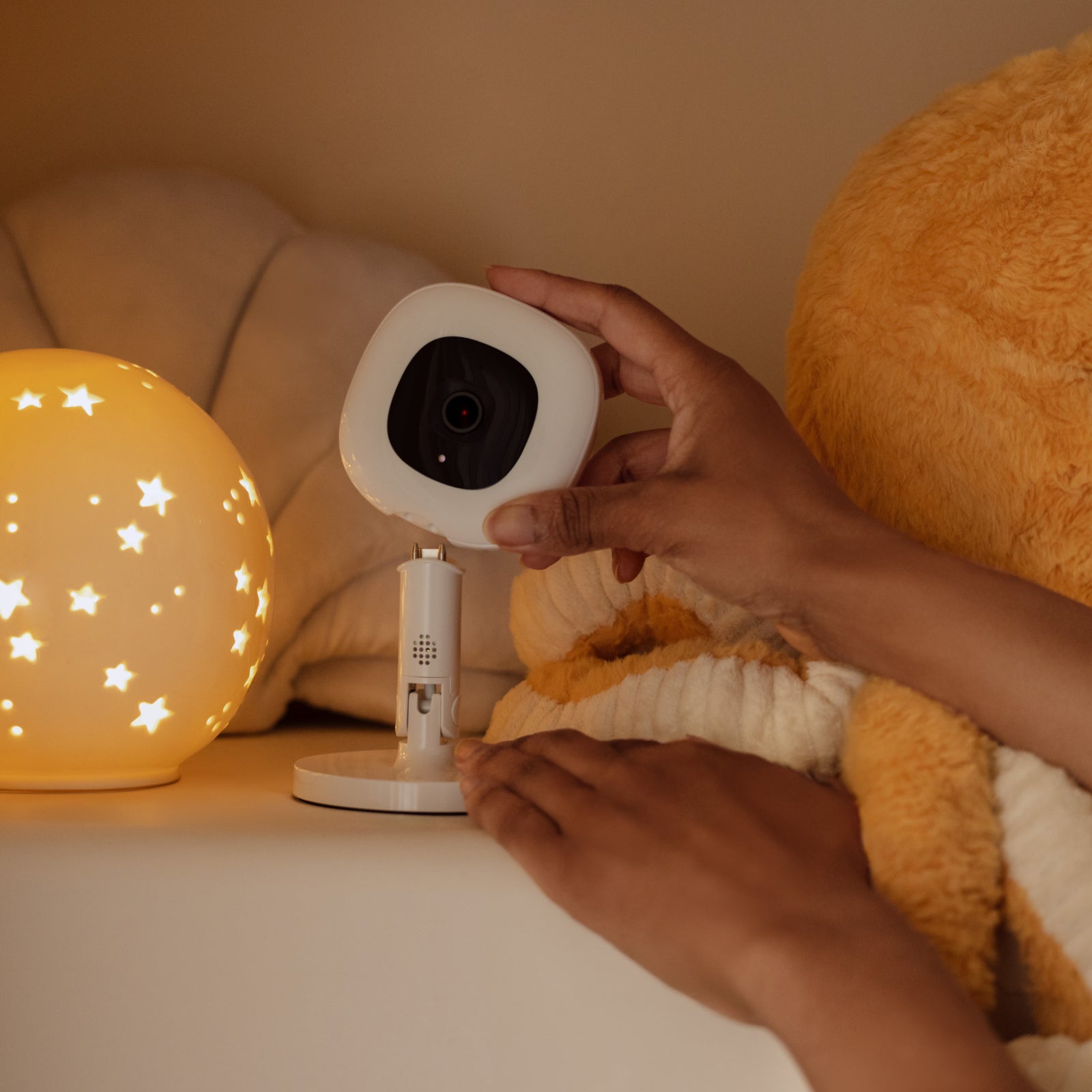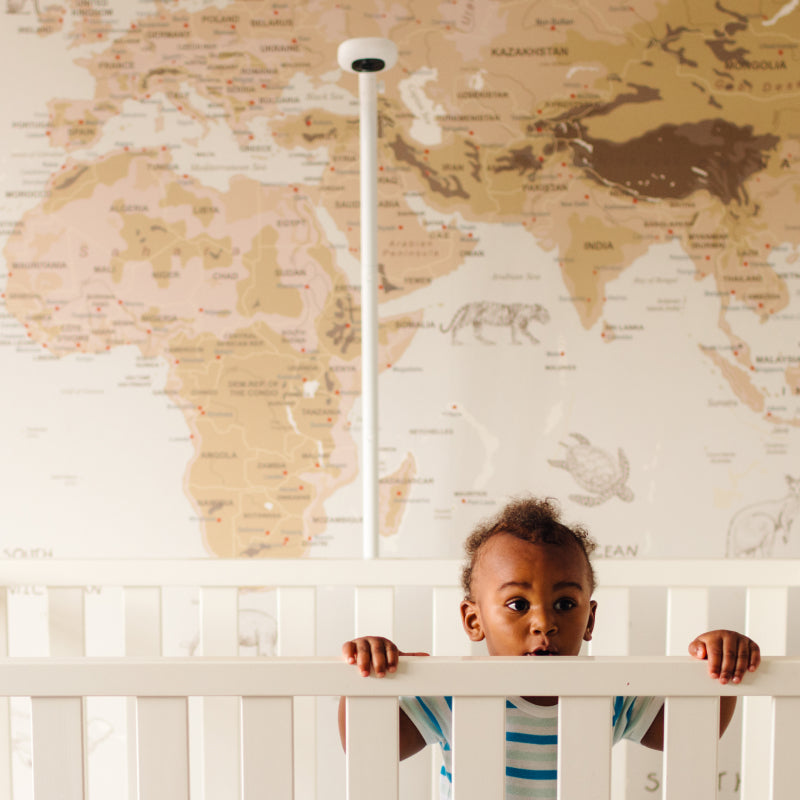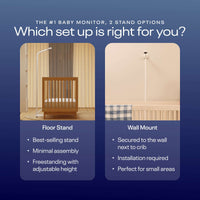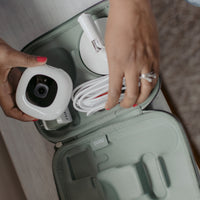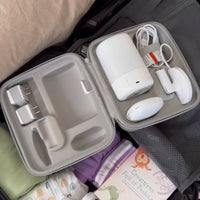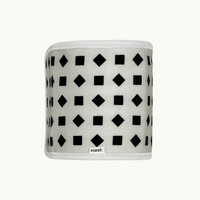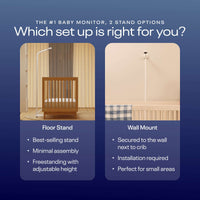Picture this. It’s 1 a.m. You’re in the middle of a particularly lovely dream about a quiet family dinner taking place in one of those dining rooms that only really exists in a Pottery Barn catalog. And then you hear it. That unmistakable cry. The baby’s awake. Again.
It’s a relatable situation for way too many parents and one of the most common sleep issues families face (not to mention one of the major reasons for Nanit’s existence!). In fact, parents on average lose 44 days of sleep in their baby’s first year alone. And, although many babies are able to sleep through the night by 6 months without waking to feed, it’s not always that simple. Even if your baby has reached that milestone, any number of issues can throw their nighttime zzz’s off, resulting in disrupted sleep for the baby and you.
Here’s what to do if your newborn or baby isn't sleeping through the night:
-
Reexamine the bedtime routine
It might seem dull and boring, but there’s power in repetition and routine, at least when it comes to your little one’s sleep. A consistent sleep schedule helps babies feel safe. If middle-of-the-night wakeups are an issue, take a moment to review your baby’s bedtime routine. How do you prepare your infant for bed each night? Do you follow the same set of steps and rituals? Or do you change things up every night?
A predictable, no-surprises bedtime routine is an absolute must. Not only does it give infants a greater sense of security, but following the same steps before bed every night lets babies know that sleepytime is coming and puts them in the sleep zone. It’s a win-win situation! The more consistent the routine the better. So, for example, if you decide to read a book before bed with your baby every night, read it in the same place. Bedtimes too should happen at the same time every night to promote healthy sleep patterns. Pick one time and stick to it as best as possible.
A sample routine for a baby over 4 months old might go down like this. After the last feed of the day, dim the lights in the house. Walk your baby over to the nursery. Read a bedtime book or two. Turn on the white noise with Nanit's Sound + Light Machine. Then place your baby in their crib, drowsy but still awake, and say something like, “I love you, sweet dreams.” Those simple actions repeated in the same way every night – even with the same signature sleep catchphrase – can make a world of difference.
The way in which your baby falls asleep at night is telling. Many experts recommend putting babies to bed drowsy, but not fully asleep, that way they can learn how to fall asleep on their own. If little ones are rocked to sleep, for example, they might get used to you doing the work of falling asleep for them. It might seem like you’re doing them a kind favor at the time. But if they wake up in the middle of the night,
this may prevent them from getting themselves back to sleep without you stepping in to rock them. Hence those dreaded midnight wakeup calls. As best as you can, weed out any negative sleep associations, aka behaviors that do the work of falling asleep for your baby, that may exist in your infant’s pre-sleep routine. That includes feeding or rocking your baby to sleep. Want to know more? Read up on negative – and positive! – sleep associations here. Believe it or not, what happens during their day schedule is just as important as what happens at night. If your baby is getting too much sleep during naptime, that might affect their ability to sleep at night. Too little sleep also plays a role. If an infant isn’t getting enough sleep at naptime, it could make them overtired, hyper and fussy, keeping them from sleeping continuously through the night. Daytime feeds also affect how your baby sleeps at night. Once you introduce solid foods around 4 to 6 months, be sure to monitor if your baby’s getting enough milk. Otherwise, they might wake up in the middle of the night on the lookout for it.
And, just like with baby’s bedtime routine, try to keep their daytime sleep schedule as consistent as possible. Baby naptimes should occur at the same times, in the same place – ideally the crib – and under the same conditions as nighttime sleep. You can even mimic the bedtime routine before naptime so that baby can get in the sleep zone. For example, dim the lights, read a book, turn on the white noise and repeat your signature sleep catchphrase. If your baby was sleeping through the night and then suddenly stopped, something could be disrupting their sleep. Often the culprit is a developmental or physical milestone that gets sleep off track momentarily. For example, if your baby is teething or learning how to stand up or crawl, that could disrupt their sleep. Other disruptors? Colds, illness, traveling and separation anxiety, which typically occurs after 6 months when your baby has a better sense of you. What can you do in the case of a sleep disruptor? Tend to your baby as needed, help them get through the disruption and then return to your baby’s regular sleep routine after the disruption has passed. You can check out our cheat sheet of common sleep disruptors and what to do about them here. Your baby’s sleep space is an important component of getting sleep right and can play a big role in helping your little snoozer sleep soundly through the night. First, it’s crucial that your baby has one single spot for sleep. For many families, that’s the nursery. If your baby’s crib is in your room or they’re sharing a room with a sibling, you can always section off the room with a divider so your baby has a distinct,
comfortable sleep space. Next, be sure to keep the room dark for sleep. The darker the better, since that cues the release of melatonin. You might even want to invest in blackout shades so that naps can take place in total darkness too. Keep the temperature of the sleep space cool to ensure your baby stays comfortable throughout the night. Footed pajamas or light layers are a good option to keep the baby cozy without overheating. And white noise is one of those sleep lifesavers that’ll cancel out any sirens, honking horns, or other bothersome sounds. Don’t forget to clear the sleep space of anything overly stimulating, like busy wall art or distracting mobiles. Nursery decor should be kept simple and soothing. Low key is actually a good thing when it comes to the sleep space. Lastly, introduce your little one to their sleep environment when they’re awake. Let them get used to the space and feel comfy in it during non-sleep hours. That way if they wake up in the middle of the night, they’re not startled to find they’re in the nursery. Data can be super helpful in making smarter decisions about your baby’s sleep. That means tracking your baby’s daytime and nighttime zzz’s, so you can look for areas to improve sleep. (Have no fear, Nanit makes sleep tracking a breeze, without requiring tedious logging or wearable devices!) For example, say you notice that your baby gets fussy around 4 p.m. or often wakes up looking for milk around midnight. All of that information can help you modify baby’s sleep plan, whether it’s adjusting a naptime or adding in more milk to baby’s diet during the day. Tracking also helps you get to know your baby’s unique sleep cues and personality so you’ll be better able to determine if they’re just a little tired, overtired or experiencing a sleep disruption. Sometimes good sleep requires a bit of sleuthing on your part, but it’s well worth it if it leads to a better night’s sleep!
Many parents feel like they have to crack the code on getting their baby to sleep all on their own, like it’s some sort of parenting test. But sleep has been leaving parents scratching their heads since pretty much the beginning of time. And it’s expected that it’s going to take time to get it right. When in doubt, turn to an expert for advice, whether it’s your pediatrician or a sleep consultant. Often they’ll be able to help decipher your baby’s sleep and recommend a number of sleep training methods that best suit your family’s needs. Even talking more openly to those in baby’s inner sleep circle – from the nanny to Grandma – can help things run a whole lot smoother. After all, good sleep isn’t a solo activity. It’s a team sport! Helping your baby sleep through the night can feel like a challenge, but with age-specific tips tailored to their development, you can further foster healthy sleep patterns and ensure restful nights for the whole family. Whether dealing with toddlers or infants, consider how each age impacts your approach to sleep solutions. Focus on Day and Night Differences: During the daytime, keep the room well-lit and active to encourage wakefulness. At night, use dim lighting and soothing routines to help your newborn adjust to nighttime sleep schedules. Soothing Techniques: Use gentle motions, white noise, or soft lullabies to help your baby fall asleep. Monitor Feeding and Wake Times: Newborns often wake up for feeding, so ensure they're comfortable and well-fed before bedtime. Establish a Bedtime Routine: Start consistent activities to signal bedtime. A predictable bedtime routine can make it easier for your infant to fall asleep. Encourage Self-Soothing: At this stage, babies can learn to fall asleep independently. Lay your baby down when they’re drowsy but still awake. Prevent Sleep Regression: Sleep regressions are common around this time. Be patient and stick to routines to help your baby sleep night after night. Naps Matter: Maintain a consistent nap schedule, ensuring your baby nap times don’t interfere with nighttime sleep. Manage Separation Anxiety: If your child experiences separation anxiety, reassure them with a calming voice or a short return to the crib without prolonged interactions. Adjust Sleep Schedules: Pay attention to signs of fatigue during the daytime and adapt the sleep schedule to meet their needs. Encourage Consistency: Keep bedtime and wake times consistent, even on weekends. Predictable routines help toddlers recognize bedtime. Set Boundaries: Toddlers may resist bedtime, so create clear yet loving rules around sleep to prevent delays. Address Nighttime Waking: If your toddler wakes up during the night, respond calmly but avoid turning it into playtime. Navigating your baby's sleep journey can be challenging, but with patience and consistency, restful nights are achievable. Remember, each baby is unique; it's important to remain flexible and responsive to your child's individual needs.
Think about how your baby falls asleep
Take a closer look at what’s going on during the day
Consider sleep disruptors
Optimize the sleep environment
Look at the numbers
Call in the reinforcements
Sleep tips for every stage
Newborns (0-3 months old)
Infants (4-6 months old)
Older babies (7-12 months old)
Toddlers (12+ months old)
Restful nights ahead
Key Takeaways



